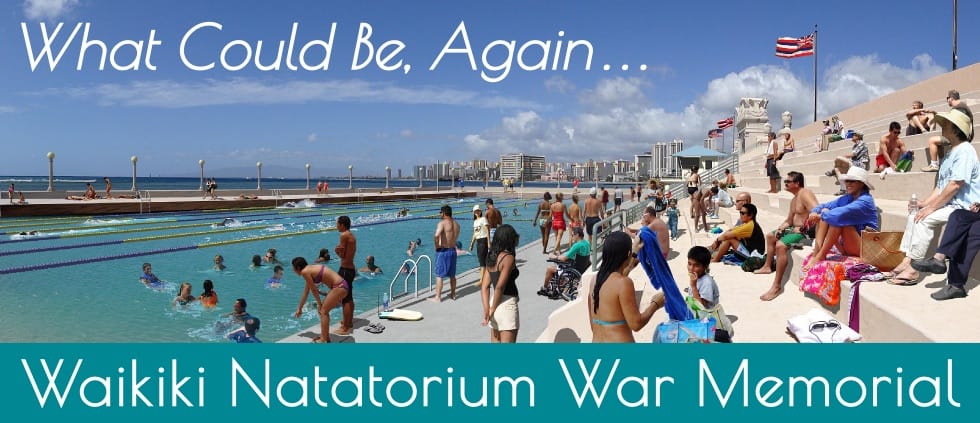Hawaii’s 1921 Territorial Legislature funds construction of the Living Memorial with its 100 X 40 meter saltwater swimming pool. It was built to honor 101 who died and the 10,000 others from Hawaii who served in World War I. Cost: $250,000.
Opened on Aug. 24, 1927, the birthday of Olympic Gold Medalist and godfather of modern surfing, Duke Kahanamoku, who dives in for the first ceremonial swim before a cheering, capacity crowd of more than 7,000.
MYTH: The arch is the memorial.
FACT: The beaux art facade is merely the entrance into the memorial natatorium, which, according to Act 15 of the 1921 Territorial Legislature, “shall include a swimming course at least 100 meters in length.”
During its heyday, the Natatorium hosts celebrity swimmers including Esther Williams, Buster Crabbe and Johnny Weissmuller as well as some 34 members of the International Swimming Hall of Fame. It is later also used by the Hawaii Department of Education for its mandatory elementary school Learn to Swim Program. Hawaii’s last Olympic swimmer learned to swim at the Natatorium.
Owned by the State but operated under an executive order by the City, the Natatorium is closed in 1979 due to 30 years of neglect. Prior to its closure, the last recorded public investment in capital maintenance is $100,000 in 1949.
MYTH: The Roll of Honor and stone it is mounted on are the memorial.
FACT: The Roll of Honor plaque is a beautiful, appropriate tribute to 101 from Hawaii who died in the Great War. But the Natatorium War Memorial was built, pursuant to 1921 legislation, to honor all the more than 10,000 men and women from the islands who served. The Natatorium was completed in 1927. The Roll of Honor was created and placed nearby, on separate park property, four years later.
On both the National and State Registers of Historic Places. Named to the National Trust for Historic Preservation’s 11 Most Endangered list in 1995. Named a National Treasure by the National Trust in 2014.
In 1997, the same ocean engineering team that designed the highly successful Ko’olina Swimming Lagoons completes exhaustive coastal conditions, structural and construction alternatives studies. After considering everything from removal to modifications to full restoration, the State concludes that complete restoration with a re-engineered pool is the most sensible option. The re-designed pool would be Hawaii’s only fully ADA-accessible saltwater swimming venue with lifts for wheelchair-bound swimmers to enter the pool.
By 1998, an environmental impact study is completed, all necessary permits are issued, and full funding ($11.5 million) is provided by the City and County of Honolulu for complete restoration for the Natatorium.
MYTH: Saving the Natatorium would cost too much.
FACT: An internationally known marine contractor and structural engineer in 2014 estimated the cost to rehabilitate and reopen the Natatorium at $20 million. That’s competitive with the cost of the dishonorable alternative: demolishing the War Memorial and replacing it with an artificial beach.
In 2001, façade, locker rooms, lifeguard offices, volleyball court and parking lot are repaired and reopened before a small but vocal opposition group uses the Department of Health to put the restoration on hold. The DOH takes three years to promulgate saltwater pool rules. By this time, construction team has demobilized, a new administration has taken over at Honolulu Hale and the project is halted.
In 2005, the remaining appropriated funds (about $6.4 million) is returned to the general fund.
A full account of the conception, design and construction of the Natatorium is told in the final chapter of the 1928 book, Hawaii in the World War by Ralph S. Kuykendall, available online here.
For more information on the Natatorium and the fight to preserve, restore, revitalize and renew Hawaii’s official World War I memorial, please visit Historic Hawaii Foundation’s special Natatorium section here. For the facts on why preservation and revitalization of the Natatorium is the right course of action and demolition is a bad idea, read our fact sheet.

Leeza
I hope Olympic swimmer Matt Biondi gets a chance to learn more about this piece of swimming history. Same thing with fellow Olympic swimmer Rowdy Gaines. Biondi lives in Hawaii. Gaines lived for a time there, as well. If they can also be honored, that would be really wonderful. Hopefully, this may also bring in more desperately needed funds to restore the Natatorium.